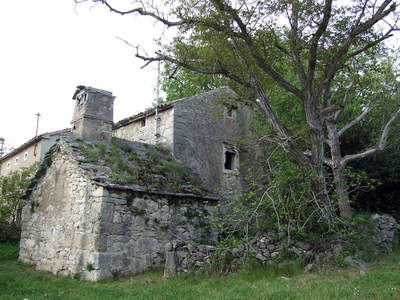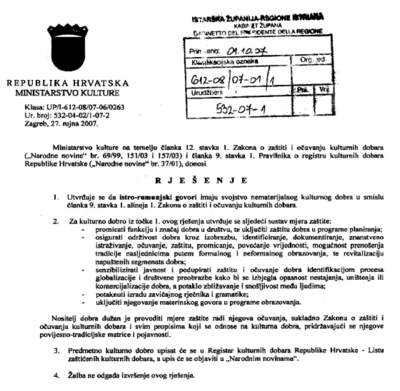 |
| Šušnjevica |
Hrvatski
A Protected Language With Only 250 People Who Can Speak It
In the explanation of the Ministry of culture, Istro-Romanian is
the most endangered cultural treasure on the Istrian peninsula. A hundred
Istro-Romanian speakers live in Zejane, about twenty in the villages around
Krsan. The most numerous are in Nova Vas, Susnjevica and Jesenovik, in a
smaller number in the villages of Letaj, Brdo, Kostrcani, Zankovci, Miheli,
Drazina, Draga and Jelavici
 |
| The decision of the Ministry
for Culture declares the Istro-Romanian speech as a non-material
cultural asset. |
PAZIN - With the resolution by the Ministry of Culture on
September 27 of this year it was declared that the
Istro-Romanian dialect is one of the most endangered cultural
treasures on Istrian territory, and it will be listed as a
protected cultural treasure of the Republic of Croatia.
Just recently, in Croatia the non-material
cultural treasures have been recognized, identified and protected, and by
this time the Ministry of Culture has evidenced seventeen of these cultural
treasures. Istro-Romanian is not the first of the Istrian protected cultural
treasure: The decree of July 12, 2007, protected: "Musical practice of
violin and bass", "Rovinj's bitinada", "Two-voice of narrow intervals from
Istria and Primorje" with four sub-categories (singing and music on tanko
and debelo, taranjkanje, bugarenje, and discanto two-voice from Galizana and
Vodnjan) then "Zvoncari" - a yearly event in Kastav, which will in their
entirety be presented on Octobar 16th in Pula.
The department for non-material cultural
treasures under the auspices of the Ministry of Culture is
responsible for processing the applications for protection status
of these non-material cultural treasures, whose member is also Lidia
Nikocevic, the curator of the Pazin Ethnographic Museum of Istria.
In this wave of registrations and protection of parts of Istrian
traditional heritage started without the possibility that the entire
complex musical system would be recognized, even internationally,
which included protection of Istrian scale and "Istrian musical
microcosm". The international protection did not succeed because the
prerequisite is that it must be first protected on the national
level, and the mentioned "microcosm", which consists of a number of
distinct systems, was concluded that it would be more effective to
protect one by one instead of all at once. Beside the musical
heritage, there were other forms of cultural treasures where
Istro-Romanian language was considered one of the most endangered
cultural treasures on the Istrian territory, and this was emphasized
in the explanation in the decree of the Ministry of Culture.
Today there are two types of
Istro-Romanian speech, the northern in Zejane and the southern in a
few villages around Krsan, with a total of 250 speakers, which
counts also the people that moved to larger cities (towns). The most
numerous are in Nova Vas, Susnjevica and Jesenovik, in a smaller
number in the villages of Letaj, Brdo, Kostrcani, Zankovci, Miheli,
Drazina, Draga and Jelavici, and according to the memories of the
current speakers, Istro-Romanian used to also be spoken in villages
Trkovci, Dolinscina, Perasi, Grobnik and Gradinje.
By proclaiming Istro-Romanian to be a
protected endangered cultural treasure, the Ministry decreed to a
degree of protection with which the "protectors of treasure" will
agree to promote the importance and function of this treasure for
society, including it into the planned programs, secure its
existence through education, identification and documentation,
scientific research, protection, promotion, increasing value,
transfer the tradition to new generations through formal and
informal education, revitalization of abandoned segments of the
treasure, sensitizing the public and supporting protection to avoid
the danger of its extinction, destruction or commercialization. One
of the duties will be to generate a dictionary and vocabulary, and
also the inclusion of Istro-Romanian speech, as a mother tongue,
into the educational programs.
In the declaration of the Ministry of
Culture it is not explained who the "protector of treasure" is, but
we believe that these are the institutions that this document is
addressed to: City of Rijeka, Opcina Krsan, Primorsko-goranska and
Istrian regional governments, the Institute for Croatian Language
and Department of Linguistics in Zagreb, the Conservation Department
in Rijeka and Pula and the Organization for the Protection of
Cultural Heritage.
Translated by Pino Golja
© https://www.istrianet.org
|